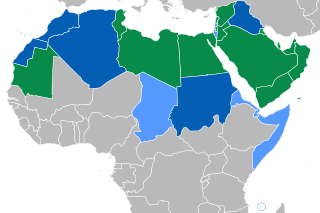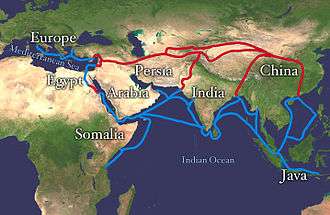Economic history of the Arab world


Economic history of the Arab world addresses history of economic activity in the Arabic-speaking countries stretching from the Atlantic Ocean in the west to the Arabian Sea in the east, and from the Mediterranean Sea in the north to the Horn of Africa and the Indian Ocean in the southeast from the time of its origins in the Arabian peninsula and spread in the 7th century CE Muslim conquests and since.
The regions conquered in the Muslim conquest included rich farming regions in the Maghreb, the Nile Valley and the Fertile Crescent. As it true of the world as a whole, agriculture dominated the economy until the modern period, with livestock grazing playing a particularly large role in the Arab world. Significant trade routes included the Silk Road, the spice trade, and the trade in gold, salt, slaves and luxury goods including ivory and feathers out of sub-Saharan Africa.
Important pre-modern industries included tanning, pottery, and metal work.
Trade routes
The economic importance of the Hajj
Jizya
Jizya is a tax imposed by Muslim governments on non-Muslim subjects. In the early centuries of Islam, jizra served as an incentive to imperialism and illegitimate wars of conquest. Conquered Christians in the Middle East and North Africa were forbidden to convert to Islam and, in cases where they were allowed to convert, it was often only on the condition that they continue to pay the jizya. For many generations Jizya was sufficient to pay a comfortable annuity to every male of the imperial Abab occupiers, enabling them to live well and serve as a self-perpetuating armed class capable of keeping their Christian subjects in tax-paying subjugation.[1][2]
According to Patricia Seed, "payment of the jizya created an economic motive for Islamic states not to have subject peoples convert..."[3]
Waqf
The Waqf is an Islamic economic institution, a financial trust for the perpetual funding of institutions, notably schools. It enables a wealthy founder to insure the economic well-being of his descendants by the mechanism of donating his estate to a waqf or trust for the support of a madrasah. The founder could legally appoint himself and his heirs as professor of law and headmaster, a position that can be passed down through the family in perpetuity and one that had the important function of insuring the ongoing prominence of a man and his descendants while "sheltering family assets" from taxation.[4][5]
Waqf could also be established for other purposes approved by shariah, notably hospitals. Scholars including Toby Huff argue that the waqf contributed to the ossification of science in the Muslim world because the law of waqf "permitted little deviation form the original founder's stipulations."[4]
Piracy
The small Muslim states on the Persian Gulf and the coast of the Maghreb were supported by a unique economic model of piracy in which the ruler regularly plundered merchant ships and launched Razzias, raids, the coasts of non-Muslim lands as far off as Ireland and Iceland to capture slaves.[6] The slaves could be profitably sold or chained as slave oarsmen to the pirate galleys, pulling the oars that powered the attacks that captured more slaves. Ship owners or their governments could pay protection money to avoid capture.
Raiding
While Arab practiced participated in the traditional Arab occupation of Razzias, caravan raiding. They led armed men to attack and plunder passing caravans.[7] This economic model remained popular among Muslim tribes for many centuries.[7] Merchants could pay protection money to the caravan raiders.
Another model of Arab raiding was practiced by armed, nomadic Bedouin tribes who attacked settled farmers - Christian in the early centuries, later also Muslim villages. This was a successful and steady income model, especially since the villagers would pay protection money and save the Bedouin the trouble and risk of actual fighting.[8]
Slavery
Oil
The discovery of large petroleum deposits in the early twentieth century revolutionized the economy of much of the region, particularly the states of Iran, Iraq, Saudi Arabia, the UAE, Kuwait, and Qatar surrounding the Persian Gulf, which are among the top oil or gas exporters worldwide. Algeria, Libya, Egypt, Tunisia, and Sudan all have smaller but significant reserves.
References
- ↑ Hugh Kennedy, The Great Arab Conquests: How the Spread of Islam Changed the World We Live In, Da Capo Press, 2008.
- ↑ David Thomas, Barbara Roggema, Christian-Muslim Relations. a Bibliographical History. Volume 1 (600-900), Brill, 2009.
- ↑ Patricia Seed, Ceremonies of possession in Europe's conquest of the New World, 1492-1640, Cambridge University Press, 1995, p. 79.
- 1 2 Toby E. Huff, The Rise of Early Modern Science; Islam China and thew West," second editor, Cambridge University Press,1993, 2003, p. 77.
- ↑ Chamberlain, Michael, Knowledge and Social Practice in Medieval Damascus,11-90-1350, Cambridge University Press, 1994.
- ↑ "British Slaves on the Barbary Coast".
- 1 2 The historical Muhammad, Irving M. Zeitlin, Polity, 2007, p. 128.
- ↑ Changing nomads in a changing world, J. Ginat, Anatoly Michailovich Khazanov, Sussex Academic Press, 1998, p. 193.
Further reading
- K. N. Chaudhuri (1999). "The Economy in Muslim Societies, chapter 5". In Francis Robinson. The Cambridge illustrated history of the Islamic world. Cambridge University Press. ISBN 978-0-521-66993-1.
- K. N. Chaudhuri. (1985) Trade and civilisation in the Indian Ocean: an economic history from the rise of Islam to 1750 CUP.
- Nelly Hanna, ed. (2002). Money, land and trade: an economic history of the Muslim Mediterranean. I.B.Tauris. ISBN 978-1-86064-699-7.
- Zvi Yehuda Hershlag (1980). Introduction to the modern economic history of the Middle East. Brill Archive. ISBN 978-90-04-06061-6.
- Timur Kuran (2011). The Long Divergence: How Islamic Law Held Back the Middle East. Princeton University Press. ISBN 978-0-691-14756-7. This is mostly about the (perceived) economic downsides of Islamic law and its (alleged) historical impact; Review in The Independent
- M. A. Cook, ed. (1970). Studies in the economic history of the Middle East: from the rise of Islam to the present day. Psychology Press. ISBN 978-0-19-713561-7. (A collection of essay on various topics roughly organized by historical period.)
- William Montgomery Watt; Pierre Cachia (1996). A history of Islamic Spain. Edinburgh University Press. ISBN 978-0-7486-0847-8., chapter 4, The Gradeur of the Umayyad Caliphate; section 2: The economic basis.
- Mohammed A. Bamyeh (1999). The social origins of Islam: mind, economy, discourse. U of Minnesota Press. ISBN 978-0-8166-3263-3. Chapter 2: Socioeconomy and the Horizon of Thought; covers the early socioeconomic history of the Arabian Peninsula